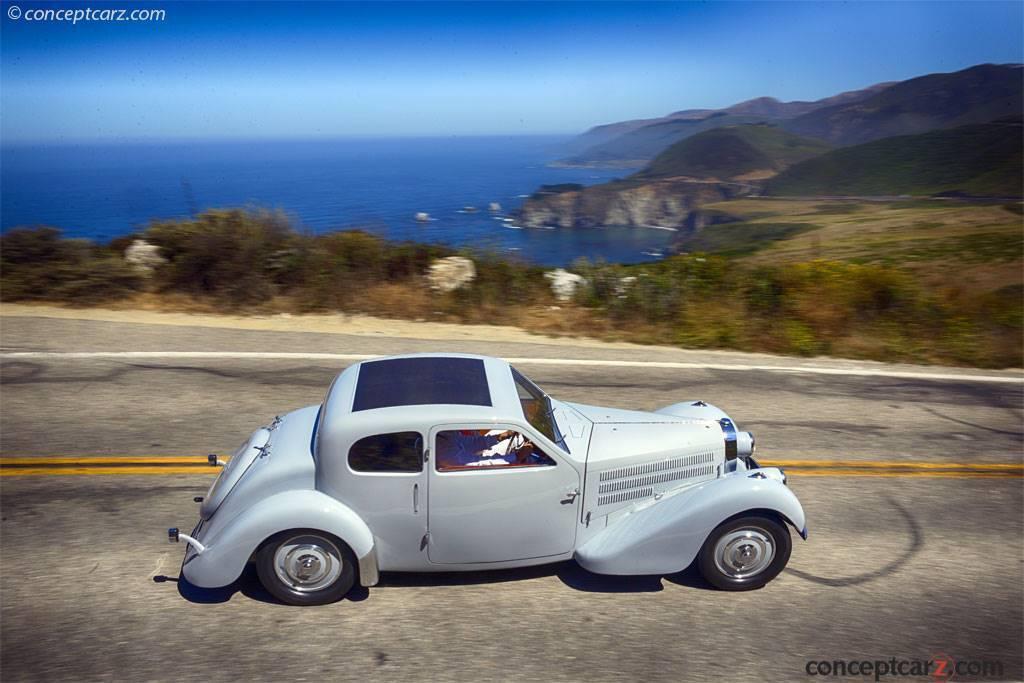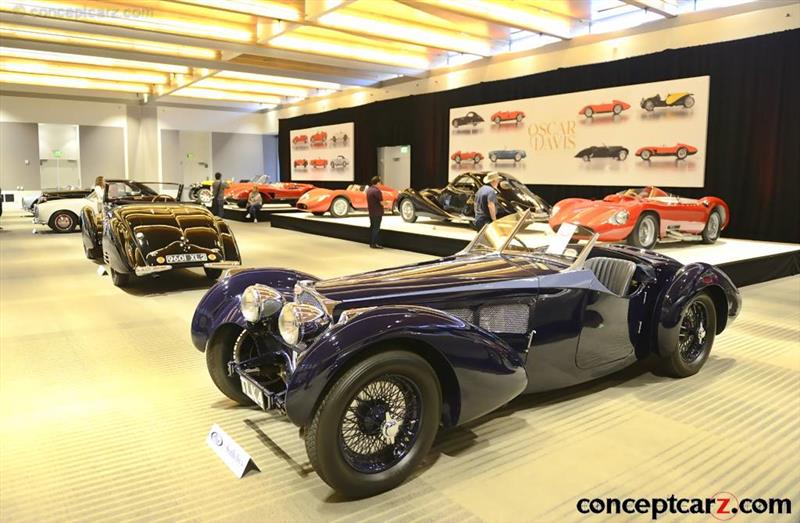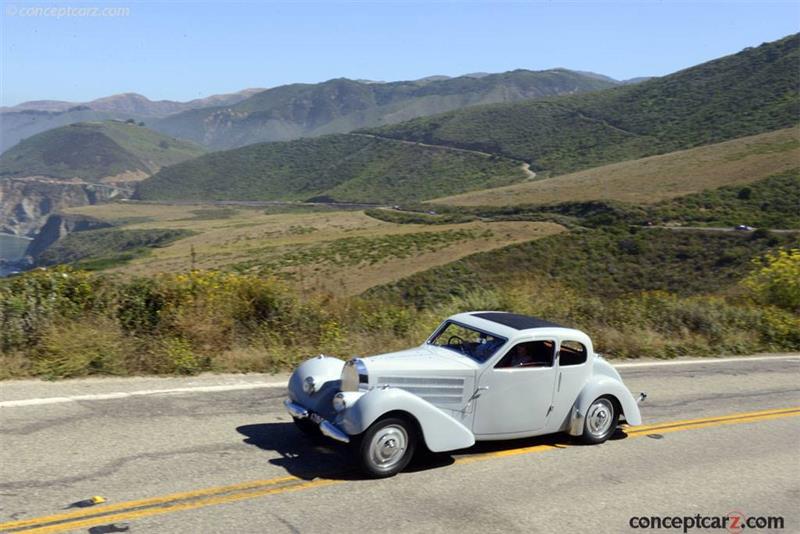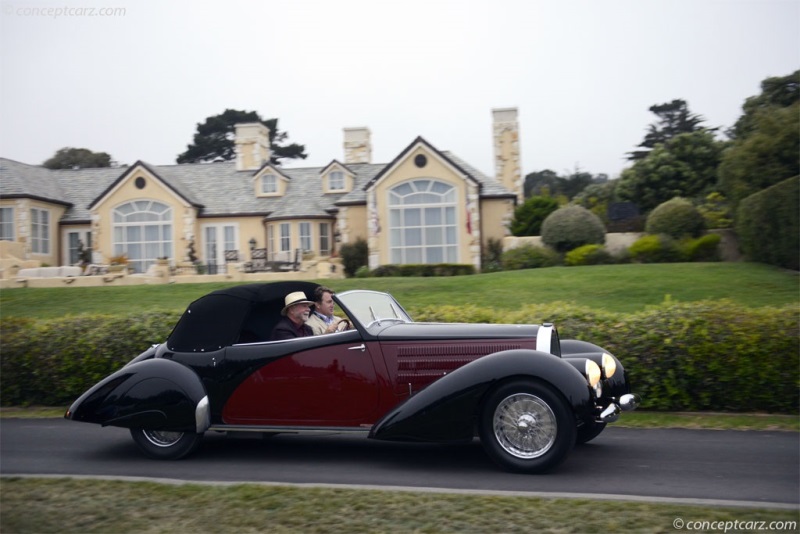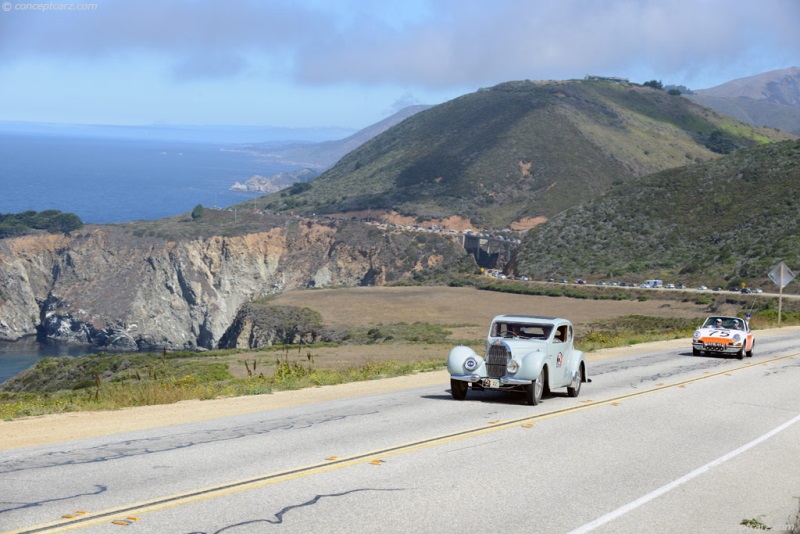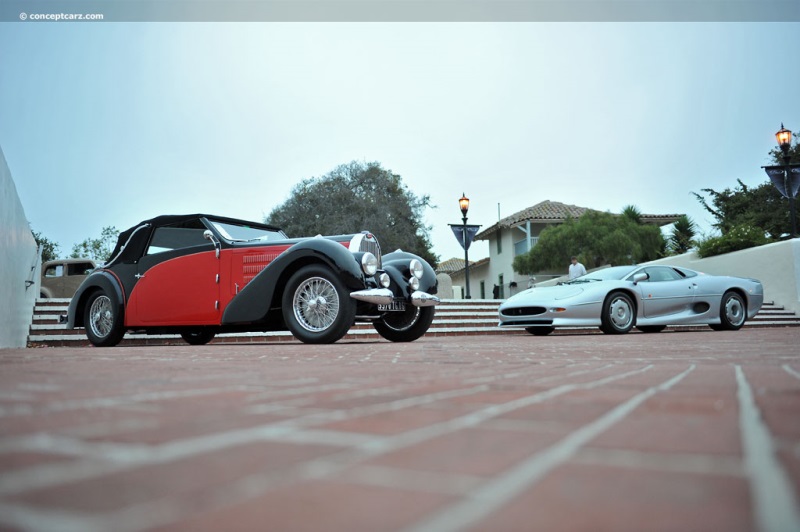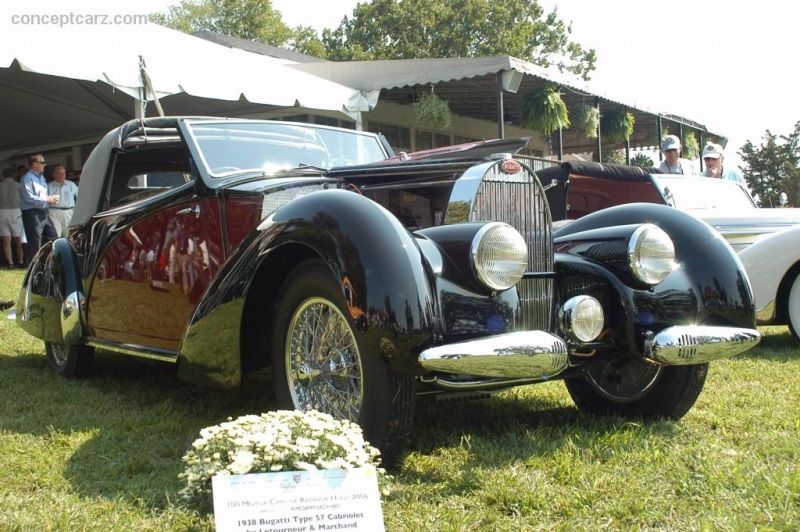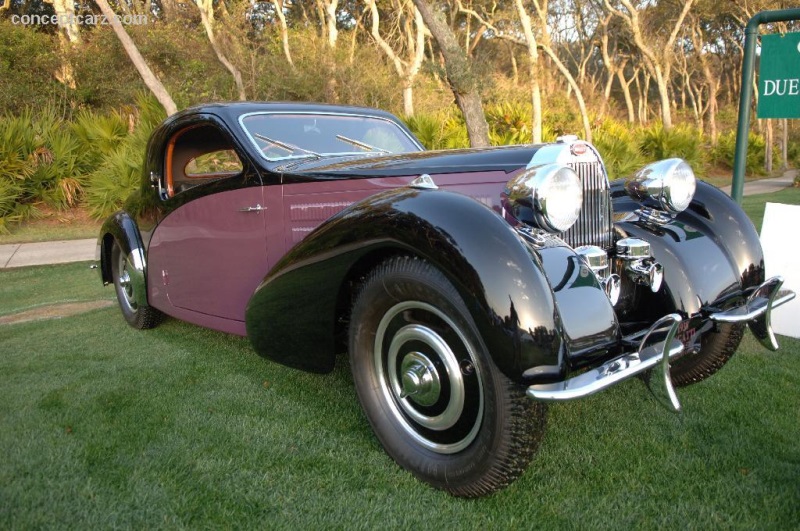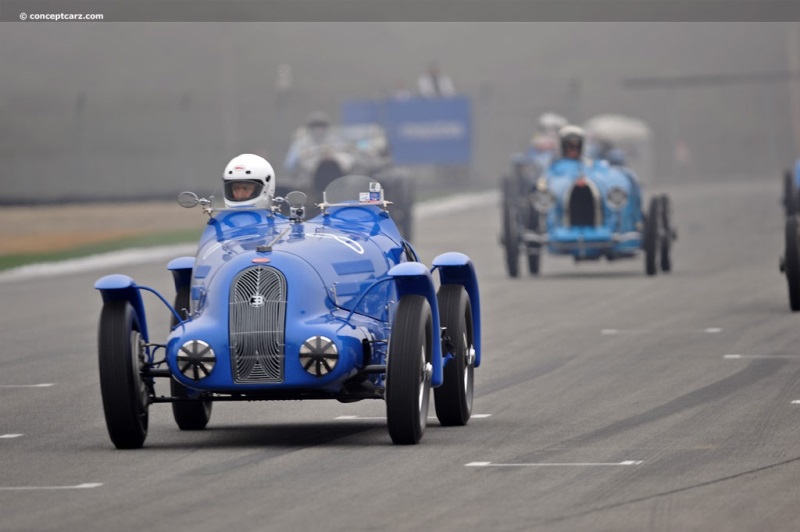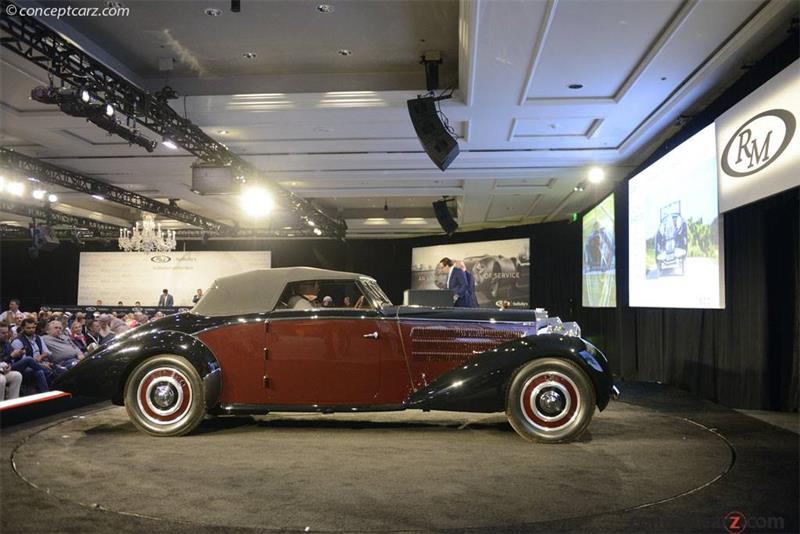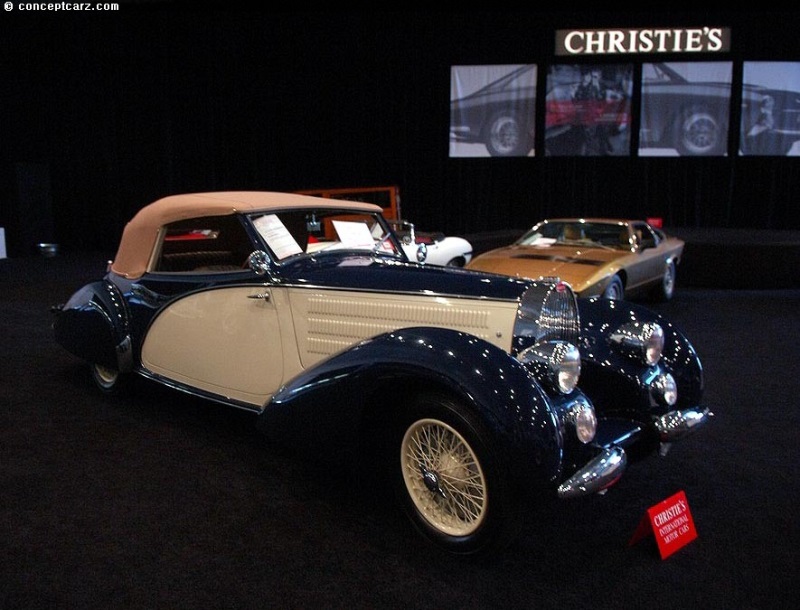1938 Bugatti Type 57 Navigation
Bugatti introduced the Type 57 in October of 1933 at the Paris Motor Show and is considered by many the epitome of 1930s sport chassis design. It had impeccable road manners, sharp handling, and a powerful and smooth engine. Production continued from 1934 through 1939, with approximately 670 examples of the Type 57 produced prior to the outbreak of World War II. 
Ventoux Coupe
View info and historyPower was from a dual overhead camshaft eight-cylinder engine with a slim squared-off block and angular machined cam covers. The cams were operated by a set of helical-toothed gears, finger cam followers minimized side thrust on the valve stems, and the long crankshaft was supported by five main bearings. Camboxes made by factory artisans in a bright-cut pattern concealed the dual overhead camshafts. The engine was backed by a gearbox that used an unconventional design for Bugatti and marked the first time the company employed this arrangement. The gearbox was fitted to the crankcase and serviced by a single-plate clutch, and the top three gears in constant mesh. Bugatti's dual overhead camshaft design was inspired by a pair of front-drive Miller 91 racing cars Ettore Bugatti had acquired from Leon Duray. Duray had briefly campaigned them on the Continent but had little success due to not have the proper multi-speed gearboxes that were needed on European circuits. Bugatti's version of the Miller's DOHC setup first appeared on the Type 50, followed by a similar design for the 3.3-liter straight eight that powered the new Type 57. In 1936, Bugatti offered a supercharged version of the Type 57, dubbed the 57C, with a Roots-type compressor driven off the camshaft drive at the rear of the engine, running at 1.17 times engine speed. With a five-to-six psi boost, the 3.3-liter rubber-mounted engine developed 160 horsepower. To help cope with the increase in power, modifications were made to the chassis to increase its strength and rigidity. 
Ventoux Coupe
Chassis #: 57599
View info and historyMany aspects of the Type 57 were advanced and at the forefront of technology, however, Ettore stubbornly refused to deviate from certain tried-and-true traditional practices. He rejected hydraulic brakes and refused to adopt independent front suspension for the Type 57, instead used a solid front axle setup with twin transverse leaf springs, and a solid rear axle with semi-elliptic leaf springs. He was also committed to his single-cam engine, only adopting the more advanced DOCH method of valve actuation, after much insistence by his eldest son Jean. From that point forward, Jean took greater responsibility for design, his first car being the Type 55 roadster of the 1930s. This design was followed by the larger and more powerful Type 57. The Type 57 was clothed in a variety of styles from elegant formal designs to high-speed, lightweight coachwork that helped the company capture victory at Le Mans. The Type 57 was solely a road-going vehicle, though a racing version was created for the 1937 24-Hours of Le Mans race. Based on the Type 57S chassis and named the 57G, it won the 24-hour race. A supercharged version was created for the 1939 edition of the race and was also victorious. Many Type 57s received bespoke bodies, including those built to Jean Bugatti's design by the marque's preferred carrossier, Gangloff of Colmar, just a few miles from the Bugatti works at Molsheim. The list of factory offerings on the Type 57 chassis includes the Stelvio cabriolet, four-seater Ventoux coupe with a steeply raked windscreen, Galibier four-door saloon, and two-seater Atalante faux cabriolet (coupe). The name Atalanta comes from Greek mythology, named after an athletic huntress who would only marry a man that could out-run her. The Ventoux was named after the forbidding Provencal mountain known for its long-established motoring hill climb and a regular Tour de France stage. The Aravis, also named after an Alpine mountain range, was a companion design to the more common four-seat cabriolet model the Stelvio. The two-seater Aravis had a dramatically sloped tail that featured a small central dorsal fin. Its design, created in 1938, was courtesy of Jean Bugatti and the Molsheim bodywork leader Joseph Walter. It is believed that no more than 12 examples of the Aravis were built at Colmar by Gangloff, and just three are known to exist today. Several more cars were built to specifications very closely resembling the factory-contracted Aravis, including as many as six by Letourneur et Marchand, albeit of a three-seat version, and D'Ieteren of Belgium built a single example in a similar style. 
Ventoux Coupe
Chassis #: 57599
View info and historyEncapsulating both form and function, the Bugatti Type 57 ranks as one of the most significant automobiles of its era.
by Daniel Vaughan | Jun 2020
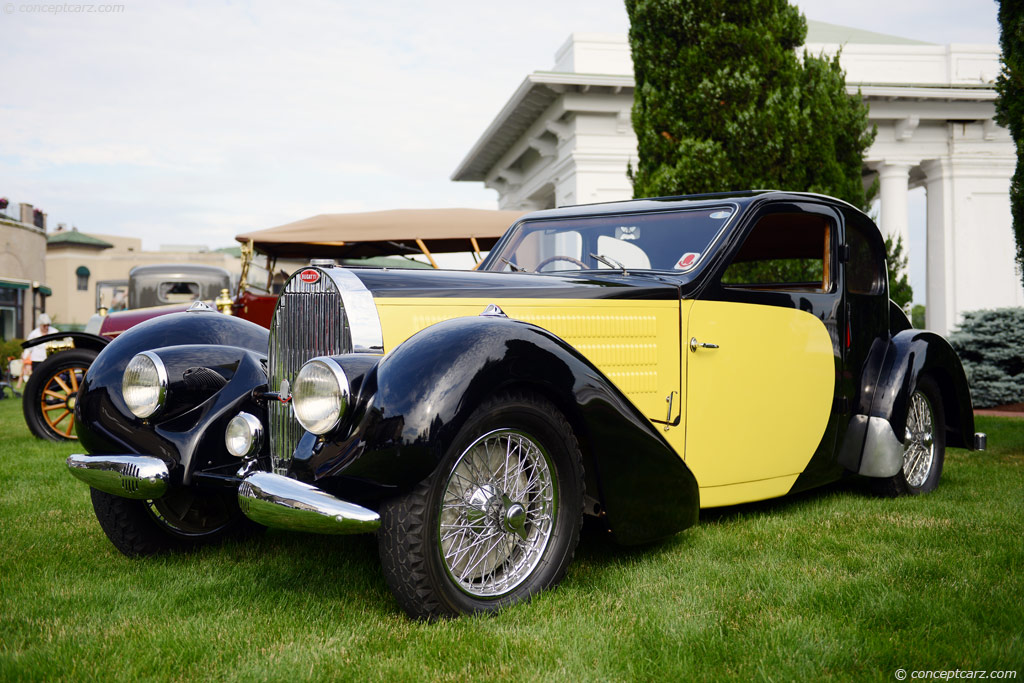
Ventoux Coupe
View info and history
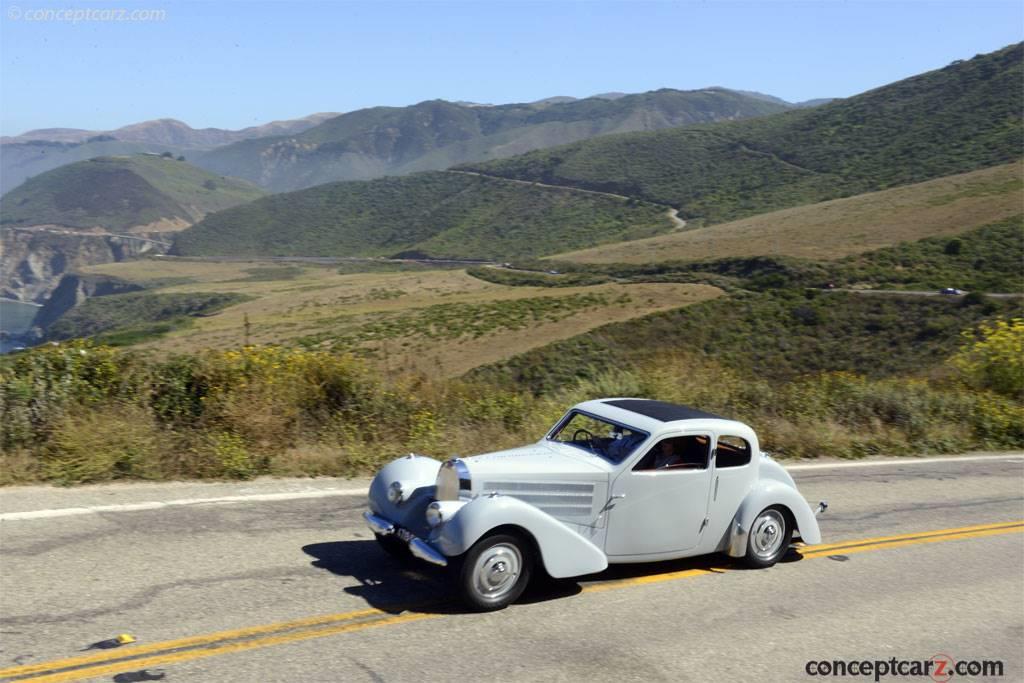
Ventoux Coupe
Chassis #: 57599
View info and history

Ventoux Coupe
Chassis #: 57599
View info and history
by Daniel Vaughan | Jun 2020
Related Reading : Bugatti Type 57 History
Many manufacturers during this time produced multi-purpose vehicles that could be driven to a race track, raced, and then driven home. The Bugatti Type 57, however, was solely a road-going vehicle and is considered the most celebrated non-racing Bugatti. Even though the Type 57 was strictly a road-going vehicle, a racing version was created for the 1937 24-Hours of Le Mans race. This vehicle, based....
Continue Reading >>
Continue Reading >>
Related Reading : Bugatti Type 57 History
Ettore Arco Isidoro Bugatti was born in Milan, Italy in 1881. His father, Carlo, was a furniture designer of some fame. The fathers brother, Rembrandt, was a gifted sculptor of animals. When he was old enough, Ettore attended the Brera Academy of Art where he studied sculpture. Soon, he turned his attention to mechanical endeavors. The first Bugatti motor car was built in 1899 though the....
Continue Reading >>
Continue Reading >>
- 1938 Bugatti Type 57 Menu
- Article
- Image gallery
- Valuation
- Specifications
- Profiles
1938 Bugatti Type 57 Vehicle Profiles
Recent Vehicle Additions
Performance and Specification Comparison
Type 57 Specification Comparison by Year
Year
Production
Wheelbase
Engine
Prices
Related Automotive News

Bugatti's greatest racer celebrates centenary at Salon Privé Concours
Bugatti Type 35 turns 100 in style at the UKs most lavish Concours
Highly original Type 35 B with continuous history represents models nadir
Part of exclusive Bugatti class including competition and touring models
Former Pebble Beach Show-winn...

The Bugatti Roadster – Pure Driving Pleasure for Almost a Century
For over 110 years, Bugatti has been developing exceptional automobiles, including numerous one-of-a-kind roadsters, renowned for their unadulterated driving pleasure.
Fast, light, and open to the elements. The two-seat roadster has always offered...

Bugatti Celebrates the 70th Anniversary of the Legendary Pebble Beach Concours d'Elegance
A Bugatti model was present at the first ever Pebble Beach Concours dElegance in Monterey, California, in 1950, and the iconic french luxury brand holds a record nine Best of Shows awards.table width100 rolepresentation border0 cellspacing0...

Coachbuilding – New Interpretation Of A Long-Established Tradition
Bugatti has been focused on delivering custom-tailored cars and extraordinary individualisation for 110 years
Since Bugatti was founded 110 years ago, its vehicles have been beyond compare – both technically and aesthetically superior. As company...

PEBBLE BEACH 2015: BUGATTI PRESENTS SUCCESSFUL SUPER SPORTS CARS FROM THE COMPANY'S HISTORY
The most successful racing car ever built, the Type 35, and the fastest production car in the world, the Veyron 16.4 Super Sport, are two of the record holders featured in the Bugatti line-up
Other highlights include a Type 57SC Roadster and Type 5...
